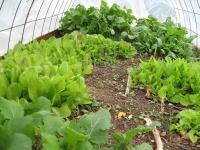Planning a Vegetable Garden in Arkansas
Fast Facts
![]() Make your plans during the winter months.
Make your plans during the winter months.
![]() The newest gardener can avoid the most common garden problems by following basic
recommendations.
The newest gardener can avoid the most common garden problems by following basic
recommendations.
![]() Decide what vegetables you wish to plant. You might find it helpful to draw a garden
diagram to find out if you have enough space to grow needed quantities. Don't forget
repeat plantings! Some vegetables may be planted each month. This will greatly decrease
the amount of space needed and keep the garden full for its most efficient use.
Decide what vegetables you wish to plant. You might find it helpful to draw a garden
diagram to find out if you have enough space to grow needed quantities. Don't forget
repeat plantings! Some vegetables may be planted each month. This will greatly decrease
the amount of space needed and keep the garden full for its most efficient use.
![]() Choose a variety well adapted to Arkansas. Recommended varieties for Arkansas can
be found in the Home Gardening Series fact sheets. Other good varieties are available and should be used where past performance is
proven.
Choose a variety well adapted to Arkansas. Recommended varieties for Arkansas can
be found in the Home Gardening Series fact sheets. Other good varieties are available and should be used where past performance is
proven.
![]() Many gardeners tend to stop after they have harvested their spring-planted crop. This
is a missed opportunity. Many crops that are normally planted in the spring grow as
well or better in the fall. While insects and diseases are sometimes more of a problem
in early fall, yields and quality are often better than in the spring.
Many gardeners tend to stop after they have harvested their spring-planted crop. This
is a missed opportunity. Many crops that are normally planted in the spring grow as
well or better in the fall. While insects and diseases are sometimes more of a problem
in early fall, yields and quality are often better than in the spring.
How do I select the right cultivar?
Many new cultivars are resistant to diseases and are heavy producers. If you have favorite cultivar that works well for you, continue to use it but you may wish to experiment with small plantings of new cultivars.
Home Gardening Series fact sheets on individual vegetables will list cultivar recommendations. In addition, new seed catalogs and web sites will list many cultivars. If a cultivar is designated to be an All-American Selection (AAS) it has been tested and found to be widely adapted.
How do I choose vegetables for the season?
Some vegetables require a cool growing season and must be planted early enough to mature before hot weather or late enough to mature in the cooler fall months. Others require warmer or even hot weather and longer periods to reach maturity.
Frost Zones for Arkansas
| Zone | Average Date of Last Spring Freeze | Average Date of First Fall Freeze |
|---|---|---|
| A | March 20 | November 15 |
| B | March 27 | November 7 |
| C | April 1 | October 30 |
| D | April 10 | October 24 |
| E | April 20 | October 20 |
Spring
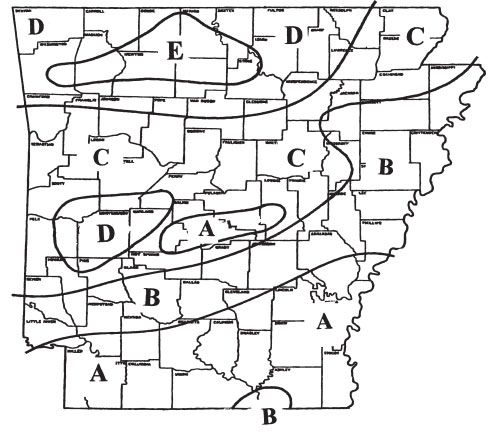
Fall
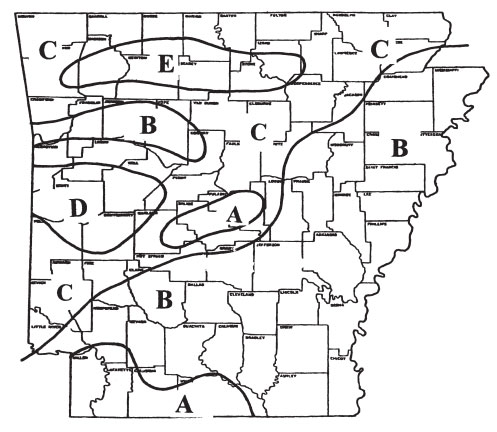
Planting Dates
- Planting Dates for Fall Vegetable Production
- Planting Dates for Spring and Summer Vegetable Production
What should I consider when selecting my garden site?
Many factors should be considered when selecting the garden site. The size of the garden is determined by the available space, the number of members in the family and how the vegetables will be used.
- Sunlight is essential to plant growth. Vegetables should receive a minimum of six
hours of direct sunlight during the day. Tomatoes, corn, peppers, cucumbers, root
crops and melons need full sunlight. Some of the leafy vegetables like cabbage, broccoli
and cauliflower will tolerate more shade.
- The roots of trees, large shrubs and hedges compete with vegetables for nutrients and moisture. Additional plant food and extra water help compensate for this competition but will not relieve shade problems.
- Surface drainage of excessive rains is desirable. Using slightly sloping areas helps, and areas that are more sloped may be used if managed properly. Contour the rows to the shape of the slope (plant around the hill). You can construct terraces or raised beds if the slope is too steep.
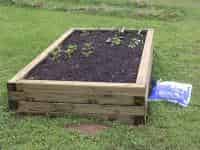
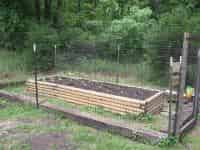
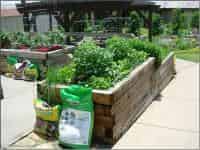
A raised bed is a convenient way to garden where soil is limited and there is poor drainage. The raised bed can be turned into a covered cold frame to extend the growing season.
Beds can be constructed for physically impaired gardeners who cannot bend over, or are in a wheel chair. Extension's AgrAbility program offers a number of resources for the home gardener with disabilities.
How to...
![]() Raised beds are made from any material that can be stacked at least 12 inches high
and is non-toxic. Landscape timbers, used railroad ties, and lumber are commonly
used materials. Concrete blocks, bricks and stones are also used.
Raised beds are made from any material that can be stacked at least 12 inches high
and is non-toxic. Landscape timbers, used railroad ties, and lumber are commonly
used materials. Concrete blocks, bricks and stones are also used.
![]() Build a frame that can hold a depth of at least 12 inches of soil. Do not make the
beds any wider than you can reach the middle of the bed.
Build a frame that can hold a depth of at least 12 inches of soil. Do not make the
beds any wider than you can reach the middle of the bed.
![]() Locate your raised bed on top of an area with drainage.
Locate your raised bed on top of an area with drainage.
| Raise it up a Notch with Raised Garden Beds | |
| Endless Gardening Volume 1, 2012 Gardening Without Pain; Don’t Let the Dirt Hurt: Stretches for Gardening; Raise It Up a Notch with Raised Beds; Community Gardening; Fruit & Vegetable Harvest Calendar | |
Want to see a demo? Watch our video How to Build a Raised Garden Bed!
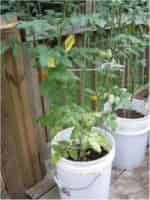
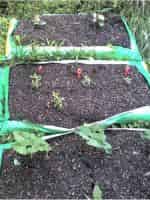
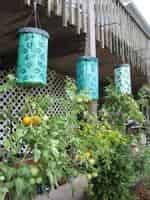
Tips for Success
![]() The perfect container for tomatoes, peppers, okra, and basil is the 5 gallon bucket.
Drill holes in the bottom of the bucket for drainage. Add 1 cubic foot of a soil-less
potting mix. Amend the soil as needed with lime, Epsom salt, and fertilizer.
The perfect container for tomatoes, peppers, okra, and basil is the 5 gallon bucket.
Drill holes in the bottom of the bucket for drainage. Add 1 cubic foot of a soil-less
potting mix. Amend the soil as needed with lime, Epsom salt, and fertilizer.
![]() Use a tomato cage to keep the plants elevated.
Use a tomato cage to keep the plants elevated.
Container gardening can also be an easy way to beautify your landscape.
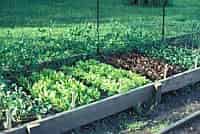
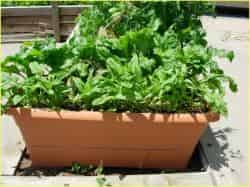
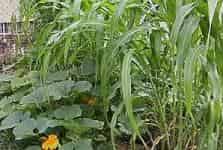
 Wide-Row Planting
Wide-Row Planting
Wide-row planting is simply broadcasting seeds in bands anywhere from 10 in. to 3 or more feet wide instead of a single band on each row. With the wide row system, more space is producing vegetables and less space is used for cultivation between the rows.
Companion Cropping
![]() Another way to use space for more intensive production is interplanting or companion
cropping. Plant tomatoes, peppers, eggplant or okra between rows of early cool-weather
crops. The early crops will mature and be out of the way before the later crops would
be crowded.
Another way to use space for more intensive production is interplanting or companion
cropping. Plant tomatoes, peppers, eggplant or okra between rows of early cool-weather
crops. The early crops will mature and be out of the way before the later crops would
be crowded.
Using Small Plants
![]() Use vegetables that require less space than others. The following vegetables make
small plants and can be closely planted in the row: radishes, turnips, lettuces,
beets, spinach, chard, arugula, cilantro, mustard, Pak choi (also called bok choy
or Chinese cabbage), scallions, and onions.
Use vegetables that require less space than others. The following vegetables make
small plants and can be closely planted in the row: radishes, turnips, lettuces,
beets, spinach, chard, arugula, cilantro, mustard, Pak choi (also called bok choy
or Chinese cabbage), scallions, and onions.
